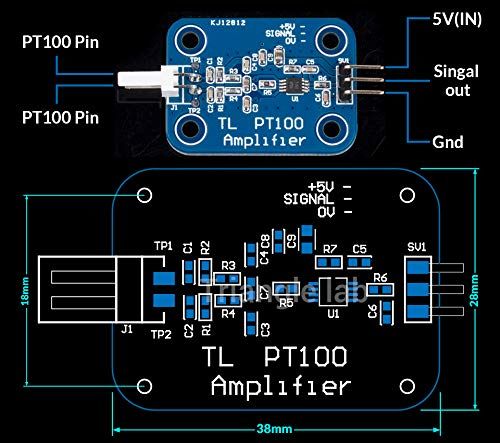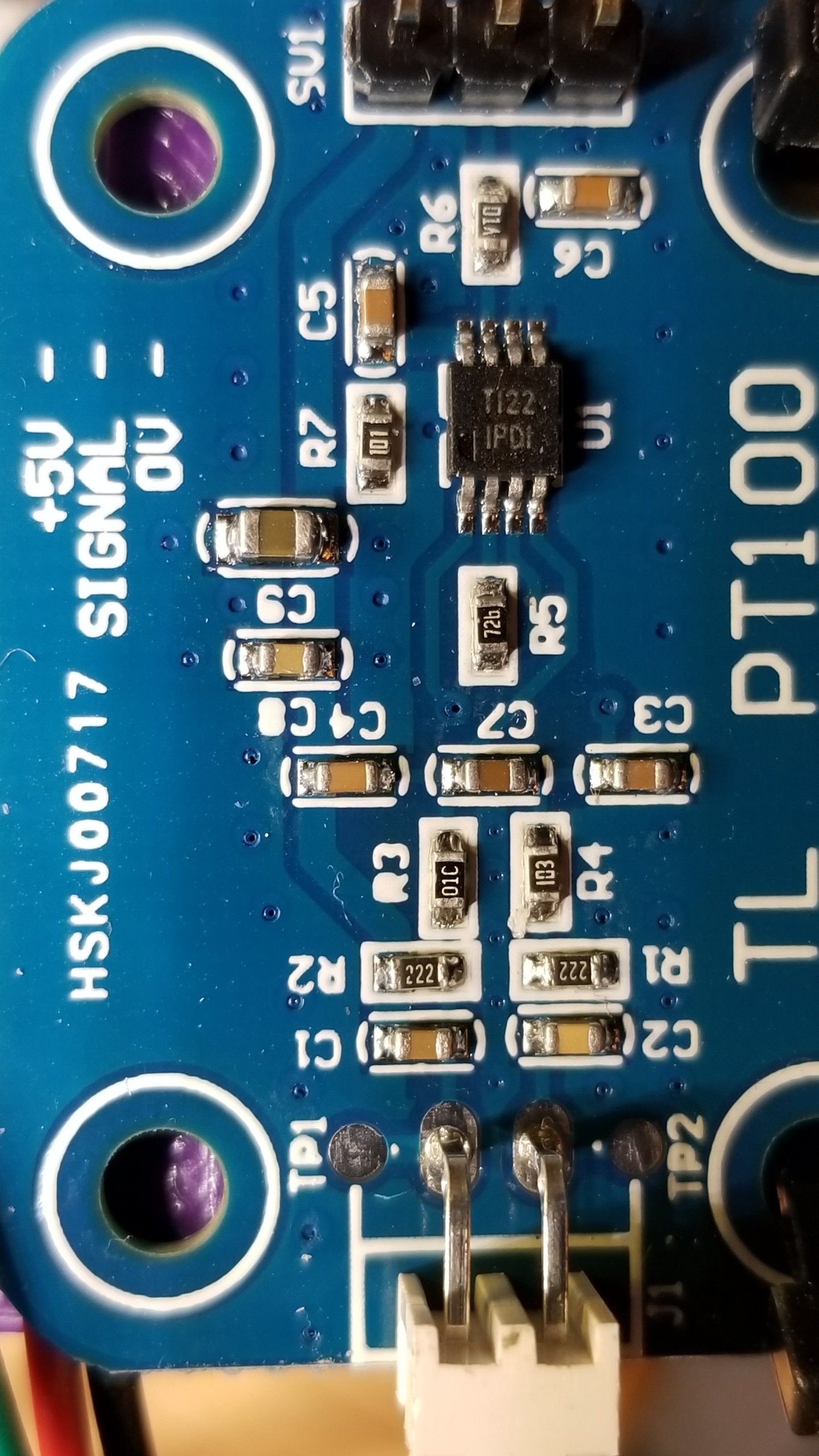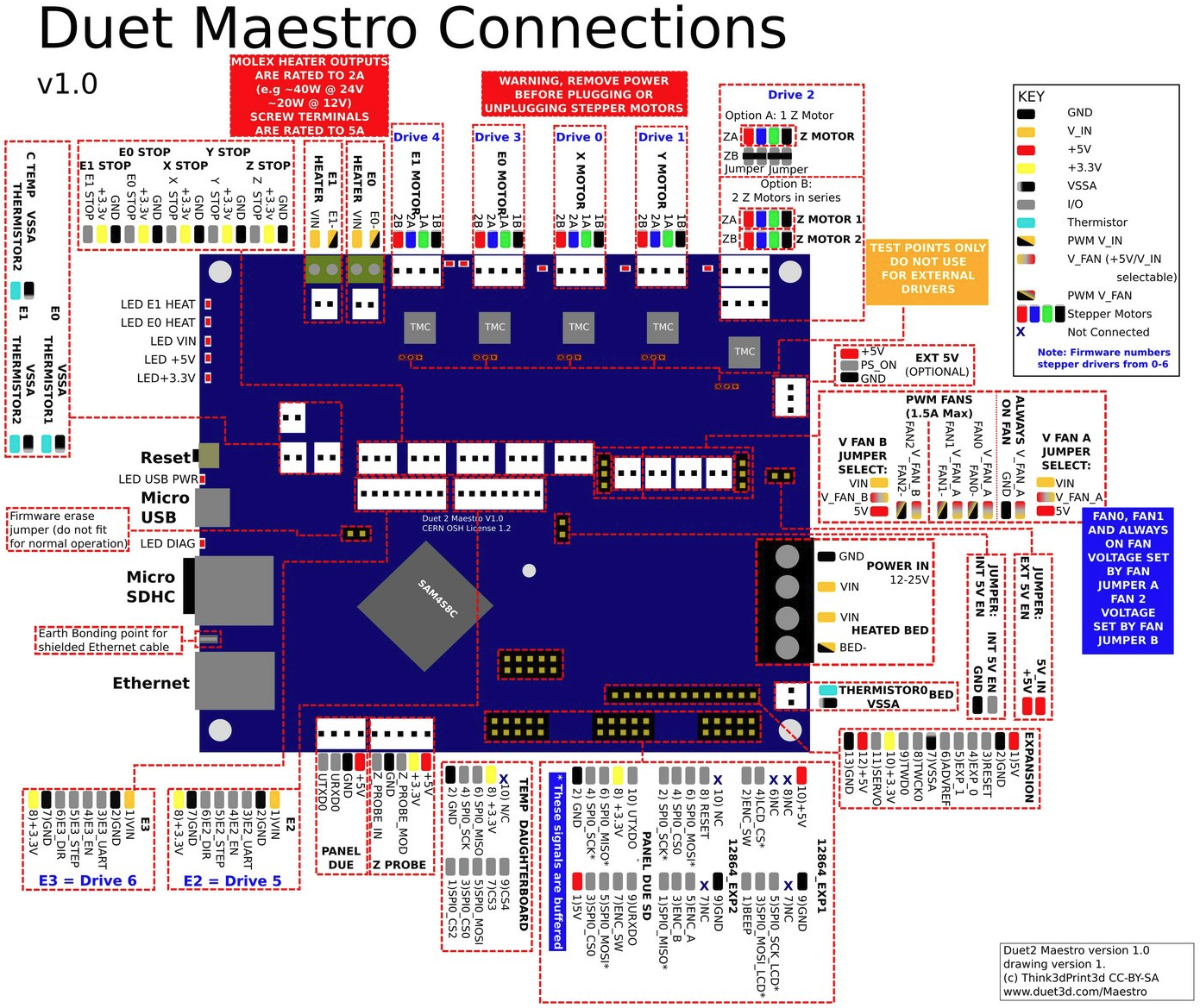PT100 on Maestro questions
-
I'm installing a Trianglelab PT100 sensor and amplifier on my Maestro / CR-10S setup and got stumped on the wiring. I'd prefer not to let out the magic smoke, so...
I did a bunch of searching and reading but 90% was addressed to the "Official" Duet PT100 board, not the clones, so not any wiring help (Trianglelab has info for Marlin, but not Duet).
The board I got (my sensor is two wire). It has three output connectors: +5vdc (well, it's input, but ...), Ground, and Singal Out (love the spelling error!). Here's the diagram:

And a closeup of the circuit board:

I was setup with a PT1000 going into E1 Thermistor 2. I'm using this Maestro guide:

I ~assume~ that the Ground goes to the Blk pin 2 (VSSA) with the Signal going to pin 1 (Aqua, left on drawing). When I checked pin 2 it reads close to zero Ω with a much higher reading on Pin 1, so I'm guessing that would be Signal and Pin 2 is Signal Ground as opposed to system ground??
Do I want to use VSSA for my reference or board ground? Where's the best place to grab the 5v, I doubt it draws much ...?
In this post:
@dc42 says "When using a PT100 with a third-party MAX31865 interface board, and the reference resistor on that board is not 400 ohms."How do I tell? Hookup and check the temp shown at room temp, then deal with it if it's not right?
The PT100 reads exactly 110Ω at 25°C (checked room temp three ways) and at the board end of the wiring it measures 110.57Ω . Do I need to put any correction factor in my config.g?
Here's my current entry (for PT1000)
M305 P1 X501 R2200 ; Set PT1000 for heater 1
M143 H1 S305 ; Set temperature limit for heater 1 to 305CI think the R2200 is redundant since that's standard for the Maestro, yes?
Thanks for any help here! EDIT - fixed readability
-
@PuterPro said in PT100 on Maestro questions:
"When using a PT100 with a third-party MAX31865 interface board, and the reference resistor on that board is not 400 ohms."
How do I tell?it has a lot more pins for the SPI interface.
@PuterPro said in PT100 on Maestro questions:
). It has three output connectors: +5vdc (well, it's input, but ...)
this probably means you have to add a voltage divider to get the output down to 3.3v before connecting anything. (or find out if the board works with 3.3v supply instead of 5v.
then its a matter of getting a analouge linear sensor configured and mapped to a temperature which I'll leave to someone else.
-
@bearer Well, while I'm fixing a line error you reply! LOL
That sounds like this board can't be used, period. So it must be a board with a MAX31865 (which I gather outputs SPI ...) ?
@dc42 mentioned in one post that you could wire directly a PT100 to the standard input an put a 10x factor in the config.g to compensate, but it wouldn't be very accurate (obviously).
I can always go back to my PT1000 ...
-
@PuterPro said in PT100 on Maestro questions:
That sounds like this board can't be used, period.
it probably can, but it'll take some doing, i'd opt for the supported PT1000 unless you find its sufficiently accurate with PT100 (can't say I noticed much error when i used PT100 for my chamber temp, but I didn't test it above 50-60C).
(if you'll consider getting a PT100 board, the Duet3d one aligns with the mounting hole
sand comes with stand offs for supporting it) -
After a bit of thought, it seems to me this board is simply a small amplifier to make up for the much smaller output of a PT100 compared to the other choices.
While the MAX31865 based boards are a full on A/D converter setup that talks to the microprocessor via a digital bus, or am I missing something? (I've done no research here, just winging it...)
Why wouldn't I be able to simply use the amplified PT100 signal on the normal thermistor input (assuming we could work out proper levels, wouldn't want to overdrive the input)? Which sorta was my original Q.
Not doubting your word, just seeking to understand it.
Please bear with me, it's been a LOT of years since my formal electronics training, so I'm a bit rusty.
-
Because if you feed it 5v it will likely output 0-5v, 3.3v is max for the Duet, so it needs to be divided, or maybe the amplifier can run off 3.3v - idk, but it would need to be adressed.
Once you have a 0-3.3v it is likely outside the range of the normal thermistors so some tweaking would be needed to correlate the voltage to a temperature.
(which is sort of my intiial answer;)
-
@bearer said in PT100 on Maestro questions:
Because if you feed it 5v it will likely output 0-5v, 3.3v is max for the Duet, so it needs to be divided, or maybe the amplifier can run off 3.3v - idk, but it would need to be adressed.
Well, that's easily checked, I've a digital bench supply I could try running the board @ 3.3v.
Once you have a 0-3.3v it is likely outside the range of the normal thermistors so some tweaking would be needed to correlate the voltage to a temperature.
Yep, agreed.
(which is sort of my intiial answer;)
LOL, yeah, but you didn't know the person you're talking to is a bit slow ...

Also fairly persistent, something you know about (I was just reading your adventures with @oliof )!
My Wife will sometimes affectionately call me a DWAB (pronounce 'dwauwb') - Dog With A Bone.Covid takes away a lot but grants us time of other things.
Any interest in helping out an old time tech on a stupid project? I could use the help, as I said, I'm a bit rusty but I have most of the tools (SMD Hot air station, Oscope, Bench meters, etc.) and some small skills.
You game?
No pressure(!), if not, I can easily go back to my PT1000, but I'd like to get this up. -
maybe next week if noone gets to it first
-
Cool. Thx. I'll check the board @ 3.3v offline see what I see. I'll post back here. Have a good week, and, as we're always saying as our closeout these days, stay safe.

EDIT: I just found what my previous searches didn't. This board I have is a clone of the E3D PT100 amp. I found the schematic and an output chart. It puts out (assuming 5v power) from 0V @ 0°C to 2.33v @ 310°C (as high as we'd likely go).
The point is, it puts out a ramped VOLTAGE, not what you want on an input expecting a temperature sensitive resistor!
To make this thing work you'd have to design a setup kinda like what is already available from Duet!!
I'm not planning on going into business competing with Duet, open source or not, LOL!
CONSIDER THIS CLOSED, YOU CAN'T GET THERE FROM HERE.
Thanks for your time @bearer ! Keep smilin'.
-
it could be shoe horned into compliance, but it'll take some effort and you'll probably loose all the benefits of using the PT100 in the first place, so I'll support your conclusion.
(after all the regular thermistor does just form a voltage divider feeding the analouge to digital converter. would just be a different voltage and a different path, and a different config, possibly some soldering, but doable. on the other hand, you'd probably loose much of the accuracy gained by using the PT100 in the first place)
-
@bearer This ---^ Yeah, I got that. Just for fun I just fired the printer up (I just replaced a bunch of the original CR-10S wiring and converted from Bowden to Direct Drive).
I tried the PT100 as E1 Thermistor (no amp board) but of course it gave me the dreaded "open circuit" reading of 2K°.
I'll try and find that post again where David mentioned using a 10x multiplier, he gave an example M305 line ... but I suspect the PT100 will have to find a new life in my old Monoprice Select V2. It always gets the hand-me-downs, HA! My Wife calls it my Frankenprinter. It already has an all metal E3D clone, so ...
My P1000 was fine, I just do a lot of PC and other high temp stuff on the CR-10S so I wanted the increased precision at high temps. Also I just setup an Aviation connector for the hotend and soldering those plugs is a PITA so I didn't want to change the sensor. Oh well.
-
this maybe helps https://forum.duet3d.com/topic/7709/controlling-a-cetus3d-with-duet3d-0-8-5/29?_=1588282264184
(although you'd probably have to use R22000 for the maestro.)
-
@bearer Yep, that was the post! Thanks!
Just wanted to check back in and post this for others chasing this madness ...
I went back to the PT1000 sensor and all's well.
HOWEVER, just for fun I hooked up the PT100 and set the config.g to R22000 and I can confirm that at least with a short wire and at room temp it does indeed work on a Maestro. I put it on my hot bed and it did climb, who knows how the curve works ... but it does indeed read.